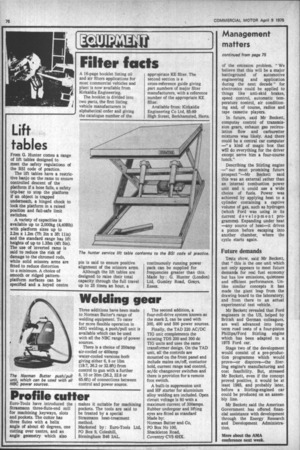Lift tables
Page 78

If you've noticed an error in this article please click here to report it so we can fix it.
From G. Hunter comes a range of lift tables designed to meet the safety regulations of the BSI code of practice.
The lift tables have a restrictive banjo on the rams to ensure controlled descent of the platform if a hose fails, a safety trip-bar to stop the platform if an object is trapped underneath, a hinged chock to lock the platform in a raised position and fail-safe limit switches.
A variety of capacities is available up to 2,000kg (4,4091b) with platform sizes up to 2.2m x 1.2m (7ft 2in x 3ft llin) and the standard range has lift heights of up to 1.35m (4ft 5in). The use of inverted rams is said to reduce the risk of damage to the chromed rods, while solid scissors arms are fitted to reduce distortion to a minimum. A choice of smooth or ridged patternplatform surfaces can be specified and a keyed centre pin is said to ensure positive alignment of the scissors arms.
Although the lift tables are designed to raise their total capacity through the full travel up to 25 times an hour, a continuously running power pack can be supplied for frequencies greater than this. Made by : G. Hunter (London) Ltd, Gumley Road, Grays, Essex.




























































































































